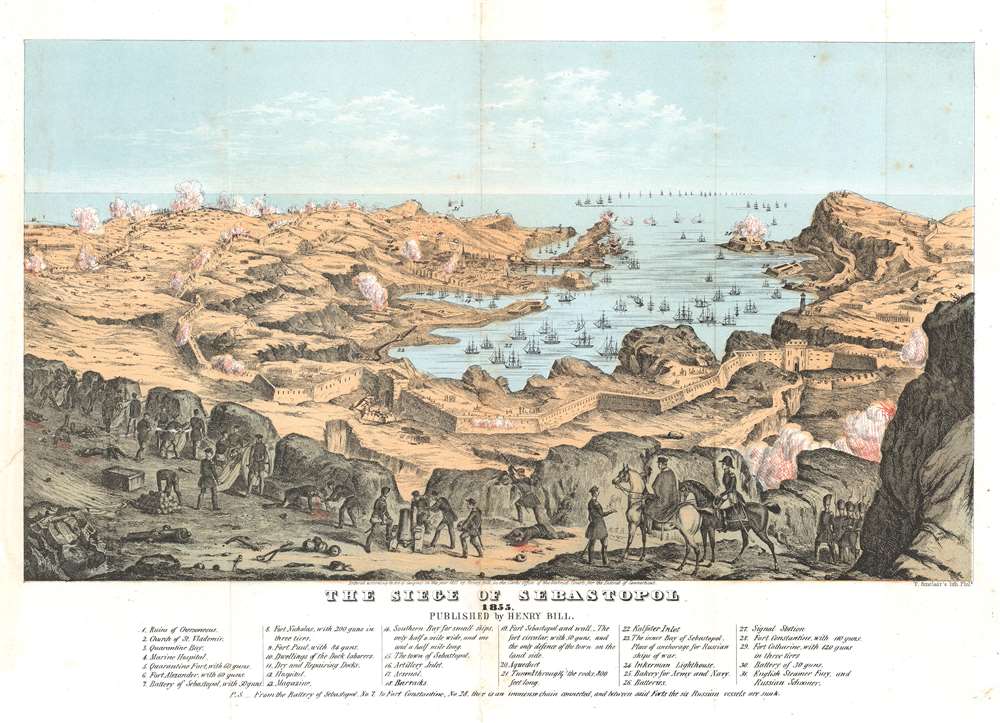1855 Bill Chromolithograph View of the Siege of Sevastopol, Crimea
SiegeSebastopol-bill-1855
Title
1855 (dated) 11.5 x 16.25 in (29.21 x 41.275 cm)
Description
The Siege of Sevastopol
The siege of Sebastopol, the final battle of the Crimean War, took place from October 1854 until September 1855. Sevastopol is remembered as one of the great sieges. The city housed Russia's Black Sea Fleet, which posed a threat to the entire Mediterranean. The great author Leo Tolstoy was then a 26-year-old artillery officer in the Russian army and survived the 11-month siege. He later immortalized the events in his Sebastopol Sketches.The Crimean War
The Crimean War, fought from October 1853 to February 1856, was an armed conflict between the Russian Empire and an alliance of the Ottoman, British, French, and Sardinian forces. The root cause of the war has never been fully understood, but the stated impetus was to defend the rights of Christians in the Holy Land, with the Catholic interests supported by the French and the Greek Orthodox Church by the Russians. The more likely root was British and French concerns about Russian expansion into the Bosporus and Mediterranean at the cost of the declining Ottoman empire.Hostilities erupted in July 1853 when Russia invaded two Ottoman suzerainties known collectively as the Danubian Principalities, labeled here as Wallachia and Moldavia. The Ottomans immediately responded, fighting a defensive campaign that halted the Russian advance at Silistra, which the Russians besieged. Alarmed by the possibility of an Ottoman collapse, the British and French entered the war, sending troops and supplies to Gallipoli. They did not arrive at Silistra until after the Russians had withdrawn.
By this time, public opinion in Britain and France, where discontent at the seemingly wasted effort and expense of sending armies to the Balkans, turned against the war. Hoping to finish the war quickly, the allies invaded the Crimean Peninsula in September, hoping to seize the Russian naval port of Sevastopol, thereby limiting Russian ability to wage war in the Black Sea arena. The supposedly 'quick and easy' siege lasted for eleven months. Russia finally sued for peace in March 1856 and in the subsequent Treaty of Paris, Russia lost its Black Sea ports, Wallachia and Moldavia gained a modicum of independence, and Christians in the Holy Land were given a degree of equality.
Publication History and Census
This view was lithographed by Thomas Sinclair and published by Henry Bill in 1855. We have identified examples in the institutional collections at Dartmouth College and Brown University.CartographerS
Henry Bill (May 18, 1824 - August 14, 1891) was an American book publisher. Born in Groton (now Ledyard), Connecticut to Lucy and Burdon Bill, Henry attended the academy in Plainfield as a boy. After graduation, Bill taught in Groton and Plainfield until, at the age of twenty, a relative, James A. Bill, offered him a job in Philadelphia workin for the book publishing business he owned. Bill spend the next three years learning the publishing business and selling books door to door in the western states. Then, in 1847, Bill moved to Norwich where he opened his own publishing firm. The elder of the Harper Brothers of New York recognized his skill and gave Bill support and an unlimited line of credit. Over the following twenty-five years, Bill's publishing company produced hundreds of thousands of books and by 1865 was among the sixty wealthiest men in Norwich. When faced with failing health and the prospect of retirement, Bill converted his business into a joint-stock company, creating the Henry Bill Publishing Company, which continued to flourish for years. Bill was also involved in politics, serving as a member of the State Senate in 1853. As a member of the Democratic Party, when the party split in 1856, he chose the anti-slavery group, and became an active member of the fledgling Republican Party. Bill was also very successful with his real estate investments and was also one of the founders of Chelsea Savings Bank, serving as the bank's vice president from 1858 until 1882. Bill married Julia O. Chapman on February 10, 1847, with whom he had seven children. More by this mapmaker...
Thomas S. Sinclair (c. 1805 - 1881) was an American lithographer. Born in the Orkney Islands, Scotland, Sinclair studied lithography in Edinburgh and other European cities before moving to the United States sometime before 1833. He was established in Philadelphia by 1833, when he drew a dancing scene for the firm of Kennedy and Lucas, which went out of business that same year. In 1838, Sinclair acquired the press of John Collins and opened his own lithography firm. He was among the first lithographers in Philadelphia to experiment with color lithography, beginning in 1843. By 1848, his skills ad advanced to such a degree that he won a silver medal for color lithography at the Franklin Institute's exhibition. Sinclair's brother, William B. Sinclair, joined the firm in 1854, and from that year until 1859 the establishment was known as Thomas Sinclair and Company. His son joined the company at one point also, and then the firm's name changed to Thomas Sinclair and Son. Sinclair died in Philadelphia in 1881. Learn More...

